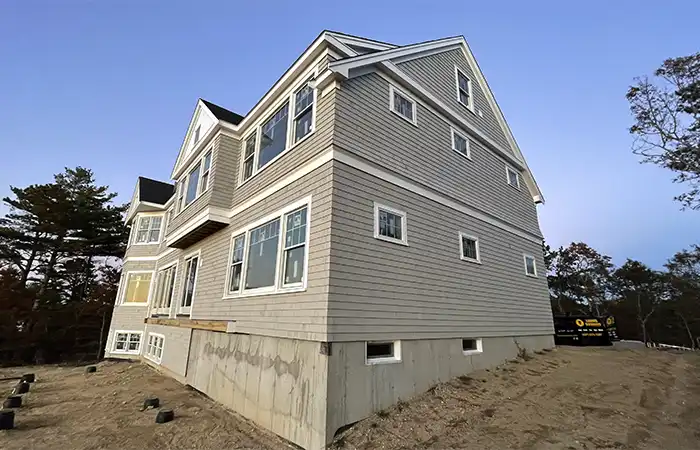Siding replacement can seem like a daunting task for any homeowner, but the rewards are well worth the effort. Not only does new siding enhance the curb appeal of your home, but it also provides crucial protection against the elements and improves energy efficiency. Whether you’re looking to replace worn-out siding or simply want an upgrade, this guide will walk you through everything you need to know about siding replacement, including:
- Understanding the importance of siding replacement
- The various types of siding materials available
- How to prepare for a siding replacement project
- Essential tools you’ll need
- A step-by-step guide to replacing your siding
- Tips for maintaining your new siding
🤔 Why Siding Replacement Matters
Siding replacement is crucial for protecting your home from the elements, enhancing curb appeal, and improving energy efficiency. It also helps prevent costly damage from leaks and rot, ensuring the longevity of your property.
Against the Elements
Your home’s siding acts as its first line of defense against harsh weather conditions. Over time, wear and tear can lead to cracks and holes, compromising your home’s integrity. Replacing your siding ensures that your home remains protected from rain, wind, and extreme temperatures.
Enhancing Curb Appeal
Siding replacement can drastically improve your home’s appearance. Whether you choose vinyl, wood, or fiber cement, new siding can give your home a fresh, updated look that attracts potential buyers and makes you proud of your property.
Increasing Energy Efficiency
Quality siding materials can improve your home’s insulation, reducing energy loss and lowering your utility bills. By choosing the right type of siding, you can enhance your home’s thermal efficiency and create a more comfortable living environment.
Types of Siding Materials
Choosing the right siding materials is crucial for protecting your home from the elements while enhancing its aesthetic appeal. Different materials offer varying levels of durability, insulation, and maintenance requirements, making informed decisions vital for long-term satisfaction and value.
- Vinyl Siding: Vinyl siding is a popular choice due to its affordability, durability, and low maintenance requirements. It comes in various colors and styles, allowing homeowners to customize their home’s look without breaking the bank.
- Wood Siding: For those who prefer a more traditional or rustic appearance, wood siding offers natural beauty and charm. Although it requires more maintenance than vinyl, its timeless appeal makes it a favorite among many homeowners.
- Fiber Cement Siding: Fiber cement siding is known for its durability and resistance to fire, termites, and rot. It mimics the appearance of wood but requires less maintenance and offers a longer lifespan, making it a wise investment for many homeowners.
🧰 Preparing for Siding Replacement
Preparing for siding replacement is crucial as it ensures your home is protected from the elements and enhances its curb appeal. Proper preparation can also lead to a smoother installation process and better long-term durability of the new siding.
Assessing Your Current Siding
Before starting any siding replacement project, it’s essential to evaluate the condition of your existing siding. Look for signs of damage, such as cracks, warping, or discoloration, to determine whether a full replacement is necessary.
Setting a Budget
Siding replacement can be a significant investment, so it’s crucial to establish a budget beforehand. Consider the cost of materials, labor, and any additional expenses that may arise during the project to ensure you’re financially prepared.
Hiring a Professional vs. DIY
While some homeowners may choose to tackle siding replacement themselves, hiring a professional ensures the job is done correctly and efficiently. Professionals have the experience and tools needed to complete the project safely and to a high standard.
Essential Tools for Siding Replacement
- Measuring Tools: Accurate measurements are crucial for a successful siding replacement project. Invest in a good-quality tape measure, a carpenter’s square, and a level to ensure precise cuts and installations.
- Cutting Tools: Depending on the type of siding you choose, you may need different cutting tools. A circular saw, utility knife, and tin snips are essential for cutting vinyl siding, while a handsaw or power saw is necessary for wood or fiber cement siding.
- Installation Tools: To properly install your new siding, you’ll need a variety of tools, including a hammer, nails, a nail gun, and a pry bar. Having these tools on hand will make the installation process more manageable and efficient.

🛠️ 7-Step Siding Replacement Guide
Replacing siding is crucial for maintaining your home’s structural integrity and enhancing its curb appeal. A well-executed siding replacement can improve energy efficiency and protect your home from the elements.
1. Remove Old Siding
Start by carefully removing the existing siding. Use a pry bar to lift the panels away from the wall, taking care not to damage the underlying structure.
2. Inspect the Underlying Wall
Once the old siding is removed, inspect the wall for any signs of damage or rot. Repair any issues before proceeding to ensure a solid foundation for the new siding.
3. Install House Wrap
House wrap acts as a moisture barrier, protecting your home from water damage. Secure it to the wall using staples or nails, ensuring it is smooth and free of wrinkles.
4. Measure and Cut New Siding
Measure your wall carefully and cut the new siding to fit. Use the appropriate cutting tools based on the type of siding material you’ve chosen.
5. Install New Siding
Starting from the bottom, attach the new siding panels to the wall using nails or a nail gun. Ensure each panel is level and overlaps the one below it to create a watertight seal.
6. Trim and Finish
Once all the panels are in place, trim any excess material and install corner pieces and trim boards to give your siding a polished, finished look.
7. Inspect and Touch Up
Finally, inspect your work for any gaps or imperfections. Make any necessary touch-ups to ensure your new siding looks flawless and functions effectively.
💡 Maintaining Your New Siding
Maintaining your new siding is crucial to ensure its longevity and protect your home from the elements. Regular upkeep not only enhances curb appeal but also prevents costly repairs down the line.
- Regular Inspections: Perform regular inspections of your siding to catch any issues early. Look for signs of damage, such as cracks, warping, or discoloration, and address them promptly to prevent further problems.
- Cleaning Your Siding: Keep your siding looking its best by cleaning it regularly. Use a mild detergent and a soft brush or cloth to remove dirt and grime, and avoid using high-pressure washers, which can cause damage.
- Addressing Repairs: If you notice any damage, such as loose panels or cracks, address them immediately. Small repairs can prevent more significant issues and prolong the life of your siding.
🙌 Transform Your Home with Expert Siding Replacement Services
Siding replacement is a worthwhile investment that enhances your home’s appearance, protects it from the elements, and improves energy efficiency. By following the steps outlined in this guide, you can ensure a successful siding replacement project that meets your needs and exceeds your expectations.At Lions Siding and Roofing Experts, we’re here to help you every step of the way. Our experienced team is dedicated to providing top-quality siding replacement services that you can trust. Contact us today to learn more about how we can assist you with your next siding project and ensure your home looks its best for years to come.

